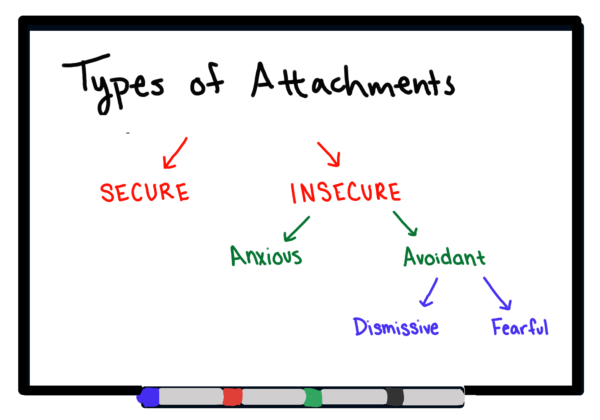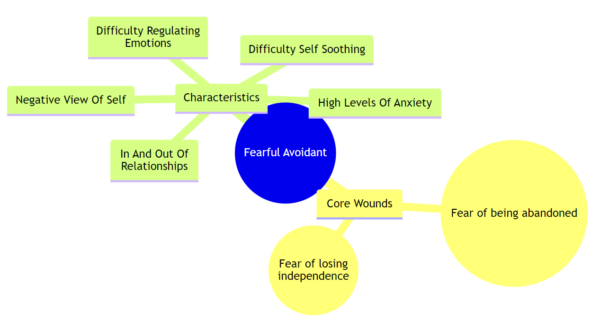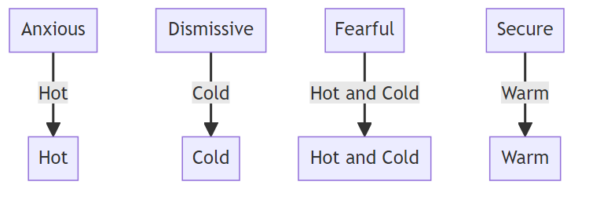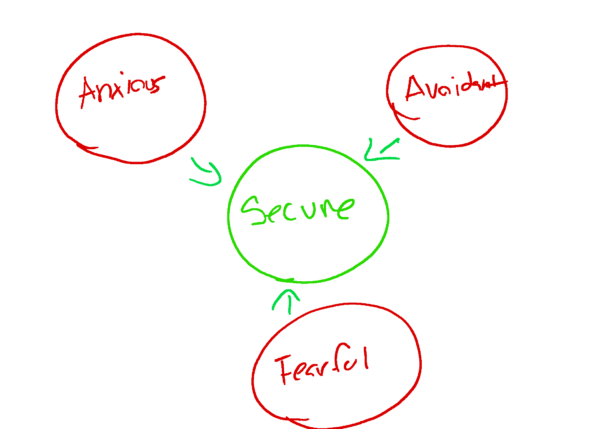Today we’re going to be talking about the major needs of a fearful avoidant.
Ultimately, a fearful avoidant has two competing needs in a relationship; A need for independence and a need for closeness.
But I wasn’t really satisfied with that. So, I started thinking and researching and ultimately found that there are ten main needs that every fearful avoidant probably requires to have a successful relationship,
- Reassurance and Affirmation: Fearful avoidants often struggle with self-doubt and fear of abandonment. Regular reassurance of love, commitment, and affection from their partner can help alleviate these fears.
- Consistent and Reliable Communication: Clear, honest, and regular communication helps build trust and reduces the misunderstandings and anxieties that fearful avoidants often experience.
- Understanding and Patience: They need a partner who understands their fears and insecurities and is patient as they navigate their mixed feelings about intimacy and independence.
- Space and Independence: While they crave closeness, fearful avoidants also need their space. Respecting their need for alone time without taking it personally is important.
- Stability and Trust: A stable and predictable relationship helps reduce the anxieties associated with fearful avoidance. Building trust is key, as it allows them to feel safer in opening up and being vulnerable.
- Emotional Support: They require a deep emotional connection and support, especially in times of stress or when they are dealing with their fears and anxieties.
- Gentle Confrontation of Issues: Addressing relationship issues in a non-threatening way is important. Aggressive confrontations can trigger their fears and lead to withdrawal.
- Growth and Self-Improvement Opportunities: Many fearful avoidants are introspective and value personal growth. A relationship that encourages and supports this can be very fulfilling for them.
- Respect for Boundaries: They may have certain triggers or boundaries stemming from past traumas or anxieties. Respecting these boundaries is essential for a healthy relationship.
- Shared Experiences and Activities: Engaging in activities together can help build a stronger bond and provide positive experiences that counterbalance their fears and insecurities.
But before we get into that I think we need to do a quick crash course on what a fearful avoidant attachment style is because contrary to what most people think, most people get the basics about them wrong.

What Are Your Chances of Getting Your Ex Boyfriend Back?
Take the quizUnderstanding The Fearful Avoidant Attachment Style
Alright, so in order to fully understand the complex fearful avoidant attachment style, you first need to understand that, unlike other insecure attachments, the fearful avoidant attachment has two core wounds.
If you’re familiar with attachment styles or the science of attachment as a whole, you’ll know that there are four main attachment styles.
However, out of these, there are three insecure attachment styles:
- The anxious attachment style, which has a core wound where the individual fears being abandoned;
- The avoidant or dismissive avoidant, which has a core wound where the individual fears losing their independence;
- And the fearful avoidant, which essentially combines both the core wounds of an anxious person and an avoidant person.
Fearful avoidant individuals are among the most difficult to diagnose because one minute they can seem incredibly anxious, and the next, incredibly avoidant.
The key component to look for here is what I like to call the ‘pendulum swing.’
A consistent behavior you’ll see from fearful avoidant individuals is their swinging from avoidant to anxious, and back, much like a pendulum. But fearful avoidant individuals aren’t simply distilled down to these two core wounds.
There’s a lot more to them than meets the eye.
- They often have difficulty self-soothing, regulating their emotion
- They usually have a really negative view of themselves.
- They’re often in and out of relationships due to this pendulum swing, and because of the volatile internal war, they usually don’t have many long-term relationships.
- They also have really high levels of anxiety.
These are all traits to look out for when diagnosing a fearful avoidant attachment style. However, perhaps there’s no better way to diagnose them than by taking that information and those concepts and also pairing them with their childhood and upbringing.
The Childhood Upbringing
- Typically, someone with a fearful avoidant attachment style grew up in an environment of childhood abuse, which could be emotional or physical.
- They often feared their parents, who may have had their own unresolved trauma.
- They might have grown up with social or economic disadvantages, creating an unstable and stressful environment.
- They might have experienced a lack of stability or routine, being left alone for extended periods of time,
- Or had a narcissistic parent with an overly critical attitude.
- Their parents might not have shown them much affection.
If this sounds familiar, then it checks off one of the boxes indicating a fearful avoidant attachment style.
The one caveat I would like to mention is that while many of the factors I’ve listed point at parents and childhood, I’ve seen that someone with a fearful avoidant attachment style can also grow up with very loving and caring parents.
The environment makes a huge difference. For example, if they had loving parents but grew up in a war zone where they were constantly afraid of their house being bombed, this can also pave the way for a fearful avoidant attachment style. So it’s not always as black and white as, ‘Hey, your parents were mean or abusive.’
The 10 Core Needs Of A Fearful Avoidant Attachment Style In Relationships
In my opinion, based on psychological principles, the most important needs for a fearful avoidant include:
- Reassurance and Affirmation: Fearful avoidants often struggle with self-doubt and fear of abandonment. Regular reassurance of love, commitment, and affection from their partner can help alleviate these fears.
- Consistent and Reliable Communication: Clear, honest, and regular communication helps build trust and reduces the misunderstandings and anxieties that fearful avoidants often experience.
- Understanding and Patience: They need a partner who understands their fears and insecurities and is patient as they navigate their mixed feelings about intimacy and independence.
- Space and Independence: While they crave closeness, fearful avoidants also need their space. Respecting their need for alone time without taking it personally is important.
- Stability and Trust: A stable and predictable relationship helps reduce the anxieties associated with fearful avoidance. Building trust is key, as it allows them to feel safer in opening up and being vulnerable.
- Emotional Support: They require a deep emotional connection and support, especially in times of stress or when they are dealing with their fears and anxieties.
- Gentle Confrontation of Issues: Addressing relationship issues in a non-threatening way is important. Aggressive confrontations can trigger their fears and lead to withdrawal.
- Growth and Self-Improvement Opportunities: Many fearful avoidants are introspective and value personal growth. A relationship that encourages and supports this can be very fulfilling for them.
- Respect for Boundaries: They may have certain triggers or boundaries stemming from past traumas or anxieties. Respecting these boundaries is essential for a healthy relationship.
- Shared Experiences and Activities: Engaging in activities together can help build a stronger bond and provide positive experiences that counterbalance their fears and insecurities.
Now, to be honest with you I think it might be a bit overkill for me to do a huge write up on each of these. I mean, let’s be honest you won’t read it anyways and trying to do all of the stuff above is likely going to be overwhelming.
Instead, I thought it might be easier to pick out a few of the most relevant “core needs” and simplify things for you.
In my opinion, these are the most important core needs you should be focusing in on,

What Are Your Chances of Getting Your Ex Boyfriend Back?
Take the quiz- Being Able To Identify Which Core Wound Is Triggered
- The Gentle Confrontation Of Issues
- Stability And Trust
Being Able To Identify Which Core Wound Is Triggered
The first need I believe is crucial for someone with a fearful avoidant attachment style in a relationship is having a partner capable of identifying which core wound is triggered and when.
This concept aligns with the 10 needs I discussed earlier,
- Such as reassurance and affirmation linked to the anxious core wound
- Space and independence associated with the avoidant core wound
- And respect for boundaries.
Essentially, this is about understanding how to speak their language by identifying their core wound.
I always try to simplify things for my clients, but we’re dealing with a complex scenario here.
- Think of it like this: an anxious person is ‘incredibly hot,’ meaning many of their behaviors involve begging, seeking reassurance, etc.
- An avoidant person is typically ‘cold,’ often being dismissive and avoiding certain interactions.
With fearful avoidants, the key is to understand when they are in a ‘hot’ moment and when they are in a ‘cold’ moment.
Typically, if they’re in a cold moment, the wise approach is to give them space, allowing them to come out of that cold moment before interacting with you.
If they’re in a hot moment, it’s smart to acknowledge it. You don’t necessarily have to fix it, as solving their problems won’t always help them heal their insecure attachment style, but making them feel heard is essential for addressing that anxious, ‘hot’ behavior.
Being able to identify which core wound is triggered is incredibly important because it allows you to speak their language, making them realize you understand them and can anticipate their needs.
However, this also means you need to be attentive to all of the hot and cold boundaries they’re setting.
At the beginning of a relationship with a fearful avoidant, it’s vital to be adept at giving them space when they need it and acknowledging their problems and need for reassurance when their anxious or ‘hot’ side is triggered.
The Gentle Confrontation Of Issues
As we’ve already established, fearful avoidants are often caught between a desire for closeness and a fear of getting too close. They might react strongly to perceived threats or criticism due to their underlying fears of abandonment and loss of autonomy.
This is why it is absolutely essential for you to adopt a “non threatening communication style” when communicating with them,
Importance of Non-Threatening Communication:
- Avoids Triggering Defense Mechanisms: Aggressive or confrontational approaches can trigger a fearful avoidant’s defense mechanisms, leading to withdrawal or heightened anxiety.
- Promotes Open Dialogue: Gentle confrontation encourages open communication and makes it more likely for the fearful avoidant to engage in a constructive conversation rather than shutting down or becoming defensive.
Ok, so we’ve bought in to this concept. How exactly are we supposed to implement it though?
- Use ‘I’ Statements: Express your feelings and needs without blaming. For example, “I feel hurt when I don’t hear from you,” instead of “You never call me.”
- Active Listening: Show that you are trying to understand their perspective. This involves listening without interrupting and reflecting back what you’ve heard.
- Empathy and Validation: Acknowledge their feelings and experiences. Even if you don’t agree, showing that you understand their perspective can be very reassuring.
- Timing and Setting: Choose a calm time and a private setting for discussions. Avoid bringing up sensitive issues during a conflict or in public.
- Focus on Solutions, Not Blame: Work together to find solutions that address both partners’ needs. Avoid focusing on who’s at fault.
Stability And Trust
So, out of the 10 things, one that stood out to me was core need number five: stability and trust.
What a fearful avoidant really needs is a stable and predictable relationship that can help reduce the anxieties associated with their attachment style. Building trust is key, as it allows them to feel safer in opening up and being vulnerable.
When I think about stability and trust, I’m reminded of the concept I learned a few years ago called ‘secure attachment gravity.’
Although there are four attachment styles, they really fall into two categories: secure and insecure. The goal in attachment theory is to help those with an insecure attachment style heal and become more secure over time.
The challenging part is that your attachment style can change based on life events. For example, a secure person can become anxious after a bad breakup, and an avoidant person can emerge from similar circumstances. This variability teaches us that just as attachment styles can shift negatively, they can also heal and become more positive.
Researchers studying this phenomenon have found that the only way to develop a more secure attachment style is to be in an environment and around people that exemplify it.
A fearful avoidant individual, therefore, needs a partner who is secure and can demonstrate how secure attachment styles approach problems.
This provides the stability and trust they need. I refer to this as ‘secure attachment gravity,’ where if you have a secure person and an insecure person, a battle ensues.
The insecure person may cause the secure person to become more insecure, or the secure person, like a cliff against the sea, remains steadfast. If this happens, the insecure attachment can become more secure over time through leading by example.
Here’s the problem with my theory: people with secure attachment styles often do not enter into relationships with, or tend to end relationships with, insecure individuals.
They recognize that the insecure person might not enrich their life. It takes a very special type of secure person to stay in a relationship with someone insecure, and that’s the paradox.

What Are Your Chances of Getting Your Ex Boyfriend Back?
Take the quizFearful avoidants need a secure partner who can teach them how healthy relationships function. However, secure individuals tend to identify red flags and insecure behaviors and often choose not to engage with them, as they value themselves highly.
Therefore, having a discussion about this for both secure and fearful avoidant people is crucial, as it can help both sides meet in the middle and understand each other better.





Kate
December 17, 2023 at 10:24 pm
Hi team
I exclusively dated a guy for 6months before warning signs;
– he didn’t want to label anything
– he only said ‘I really, really like you’
– he didn’t make much time for me
I ended it in July but he occasionally messages then disappears. Though I removed him on social media, he looks at my stories.
What shall I do? I think he has commitment issues due to a bad breakup.
Thanks
Coach Shaunna
December 31, 2023 at 4:35 am
Hi Kate, spending your time working on yourself to become more secure than anxious during your No contact period, then reach out once you have completed a 21 days NC or a 30 days if you need more time to work on yourself. Be sure that you read and understand how to reach out for the first time after your NC is complete.